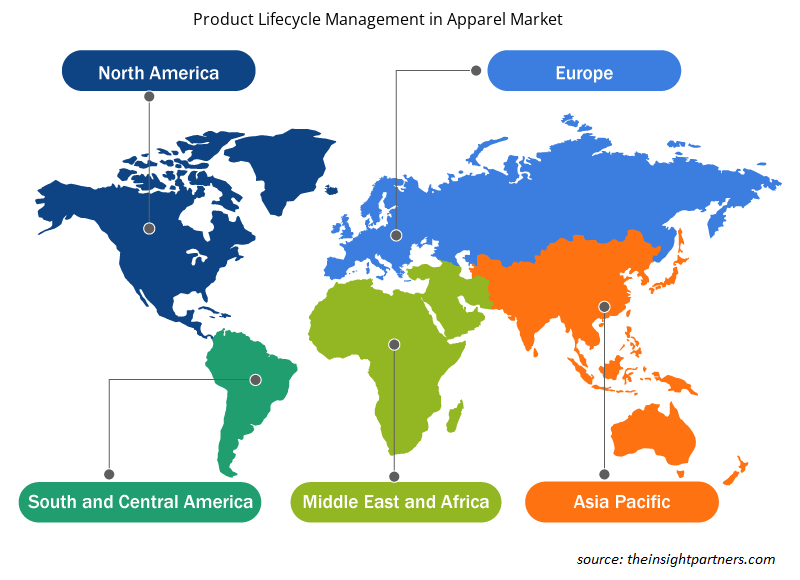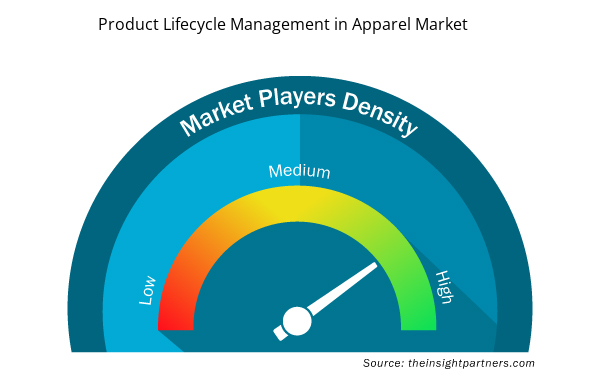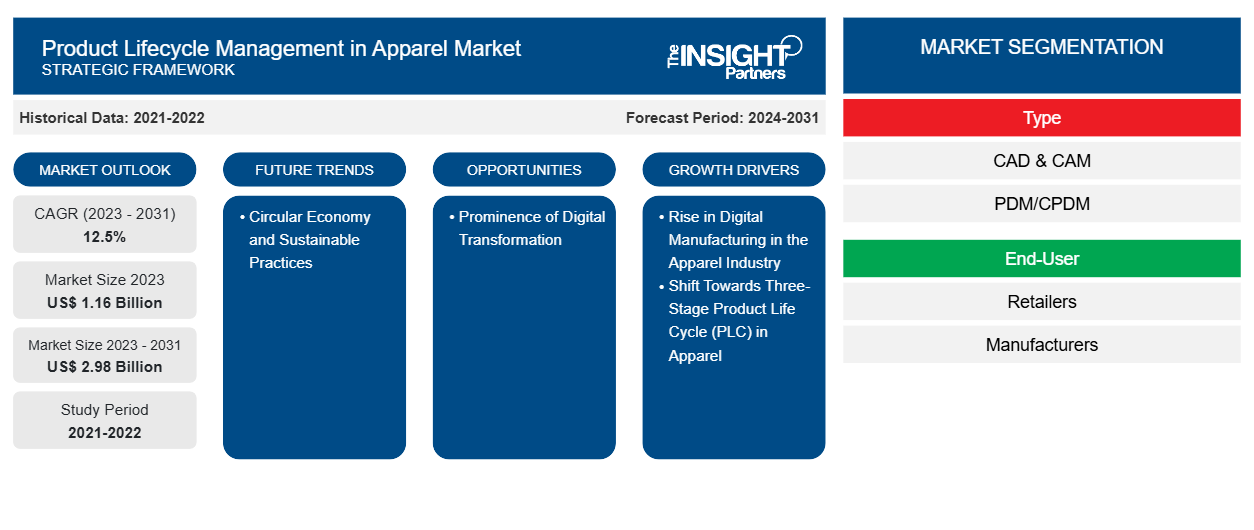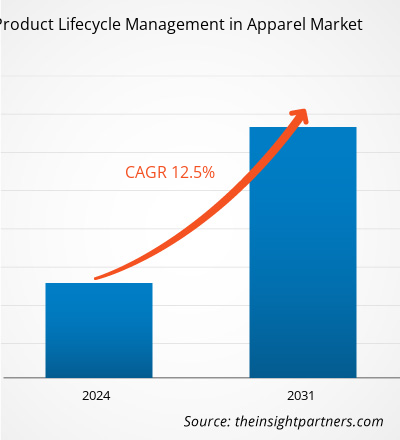من المتوقع أن يصل حجم إدارة دورة حياة المنتج في سوق الملابس إلى 2.98 مليار دولار أمريكي بحلول عام 2031 من 1.16 مليار دولار أمريكي في عام 2023. ومن المتوقع أن يسجل السوق معدل نمو سنوي مركب بنسبة 12.5٪ في الفترة 2023-2031. ومن المرجح أن يظل الاقتصاد الدائري والممارسات المستدامة والتركيز على التحول الرقمي من أهم عوامل إدارة دورة حياة المنتج في اتجاهات سوق الملابس.
إدارة دورة حياة المنتج في تحليل سوق الملابس
تتسم صناعة الأزياء بالتحولات السريعة في أذواق المستهلكين، فضلاً عن قِصَر أعمار المنتجات، الأمر الذي يزيد من تعقيدها. وتخلق هذه التغيرات صعوبات وآفاقاً جديدة في مجالات متعددة من هذا القطاع، مثل التصنيع، وطرق الإنتاج، والمعايير، وجهود الإعلان والتسويق.
نظرة عامة على إدارة دورة حياة المنتج في سوق الملابس
في صناعة الملابس، تعد إدارة دورة حياة المنتج (PLM) نهجًا استراتيجيًا للإشراف على الرحلة الكاملة للمنتج، من تصميمه الأولي وتطويره إلى إطلاقه الرسمي وخدمته والتخلص منه. تتضمن هذه الطريقة الشاملة إدارة جميع الأنشطة المتعلقة بدورة حياة المنتج، مثل التصنيع والتسويق والإزالة النهائية من السوق. من خلال نهج إدارة دورة حياة المنتج، يمكن للصناعة تحليل مدى قبول المنتج في السوق بمرور الوقت، بما في ذلك التقلبات الكبيرة في المبيعات.
قم بتخصيص هذا التقرير ليناسب متطلباتك
ستحصل على تخصيص لأي تقرير - مجانًا - بما في ذلك أجزاء من هذا التقرير، أو تحليل على مستوى الدولة، وحزمة بيانات Excel، بالإضافة إلى الاستفادة من العروض والخصومات الرائعة للشركات الناشئة والجامعات
- احصل على أهم اتجاهات السوق الرئيسية لهذا التقرير.ستتضمن هذه العينة المجانية تحليلاً للبيانات، بدءًا من اتجاهات السوق وحتى التقديرات والتوقعات.
إدارة دورة حياة المنتج في سوق الملابس: العوامل المحركة والفرص
ارتفاع التصنيع الرقمي في صناعة الملابس لتعزيز السوق
من المتوقع أن يكون لارتفاع التصنيع الرقمي في صناعة الملابس تأثير كبير على متطلبات أنظمة إدارة دورة حياة المنتج القوية والموثوقة. ويرجع هذا إلى حد كبير إلى العمليات المعقدة المشاركة في التصنيع الرقمي، بما في ذلك التصور والتصميم والتخطيط والتنفيذ، والتي تتطلب جميعها استخدامًا مكثفًا لبرامج إدارة دورة حياة المنتج مثل CAD و CAM. ونتيجة لذلك، من المتوقع أن يؤدي توسع التصنيع الرقمي إلى تعزيز الحاجة إلى أنظمة إدارة دورة حياة المنتج، وبالتالي دفع تقدم إدارة دورة حياة المنتج في سوق الملابس خلال الفترة المتوقعة.
أهمية التحول الرقمي
لقد فتح التحول المستمر نحو الرقمنة آفاقًا جديدة للابتكار، حيث تم دمج التقنيات المتقدمة مثل التعلم الآلي والذكاء الاصطناعي والروبوتات وإنترنت الأشياء لتمهيد الطريق إلى عصر الثورة الصناعية الرابعة (الصناعة 4.0). في الصناعة 4.0، يسهل دمج الإلكترونيات وتكنولوجيا المعلومات التكامل الرقمي السلس للجوانب المادية والرقمية والبيولوجية للحياة البشرية الحديثة. وهذا يمثل تغييرًا كبيرًا لصناعة التصنيع، وخاصة في إنتاج السلع المصنعة بكميات كبيرة مثل الملابس والأحذية، حيث تحرض الصناعة 4.0 تحولًا ثوريًا.
تقرير تحليل تجزئة تقرير إدارة دورة حياة المنتج في سوق الملابس
إن القطاعات الرئيسية التي ساهمت في اشتقاق إدارة دورة حياة المنتج في تحليل سوق الملابس هي النوع والمستخدم النهائي.
- بناءً على النوع، ينقسم السوق إلى CAD & CAM وPDM/CPDM. احتل قطاع CAD & CAM حصة سوقية كبيرة في عام 2023.
- من حيث المستخدمين النهائيين، يتم تقسيم السوق إلى تجار التجزئة،الشركات المصنعة وغيرها. استحوذ قطاع الشركات المصنعة على حصة كبيرة من السوق في عام 2023.
تحليل حصة سوق إدارة دورة حياة المنتج في الملابس حسب المنطقة الجغرافية
ينقسم النطاق الجغرافي لتقرير إدارة دورة حياة المنتج في سوق الملابس بشكل أساسي إلى خمس مناطق: أمريكا الشمالية، ومنطقة آسيا والمحيط الهادئ، وأوروبا، والشرق الأوسط وأفريقيا، وأمريكا الجنوبية/أمريكا الجنوبية والوسطى.
تشمل إدارة دورة حياة المنتج في سوق الملابس في أوروبا إدارة دورة حياة منتجات الأزياء بالكامل، ومعالجة التحديات الفريدة التي تفرضها الاتجاهات السريعة وتفضيلات المستهلكين. ومن المتوقع أن يشهد السوق نموًا كبيرًا، والتكيف مع ديناميكيات السوق المتغيرة يوفر فرصًا للشركات في صناعة الملابس الأوروبية.
إدارة دورة حياة المنتج في سوق الملابس: رؤى إقليمية
لقد قام المحللون في Insight Partners بشرح الاتجاهات والعوامل الإقليمية المؤثرة على إدارة دورة حياة المنتج في سوق الملابس طوال فترة التوقعات بشكل شامل. يناقش هذا القسم أيضًا قطاعات سوق إدارة دورة حياة المنتج في الملابس والجغرافيا في جميع أنحاء أمريكا الشمالية وأوروبا ومنطقة آسيا والمحيط الهادئ والشرق الأوسط وأفريقيا وأمريكا الجنوبية والوسطى.

- احصل على البيانات الإقليمية المحددة لإدارة دورة حياة المنتج في سوق الملابس
نطاق تقرير إدارة دورة حياة المنتج في سوق الملابس
| سمة التقرير | تفاصيل |
|---|---|
| حجم السوق في عام 2023 | 1.16 مليار دولار أمريكي |
| حجم السوق بحلول عام 2031 | 2.98 مليار دولار أمريكي |
| معدل النمو السنوي المركب العالمي (2023 - 2031) | 12.5% |
| البيانات التاريخية | 2021-2022 |
| فترة التنبؤ | 2024-2031 |
| القطاعات المغطاة | حسب النوع
|
| المناطق والدول المغطاة | أمريكا الشمالية
|
| قادة السوق وملفات تعريف الشركات الرئيسية |
|
إدارة دورة حياة المنتج في كثافة اللاعبين في سوق الملابس: فهم تأثيرها على ديناميكيات الأعمال
يشهد سوق إدارة دورة حياة المنتج في سوق الملابس نموًا سريعًا، مدفوعًا بالطلب المتزايد من المستخدم النهائي بسبب عوامل مثل تفضيلات المستهلك المتطورة والتقدم التكنولوجي والوعي الأكبر بفوائد المنتج. ومع ارتفاع الطلب، تعمل الشركات على توسيع عروضها والابتكار لتلبية احتياجات المستهلكين والاستفادة من الاتجاهات الناشئة، مما يؤدي إلى زيادة نمو السوق.
تشير كثافة اللاعبين في السوق إلى توزيع الشركات أو المؤسسات العاملة في سوق أو صناعة معينة. وهي تشير إلى عدد المنافسين (اللاعبين في السوق) الموجودين في مساحة سوق معينة نسبة إلى حجمها أو قيمتها السوقية الإجمالية.
الشركات الرئيسية العاملة في إدارة دورة حياة المنتج في سوق الملابس هي:
- سي ديزاين للأزياء
- الحلول التي تم إنشاؤها بواسطة الكمبيوتر
- داسو سيستمز
- EFI أوبتيتكس
- شركة جيربر للتكنولوجيا
- شركة إنفور
إخلاء المسؤولية : الشركات المذكورة أعلاه ليست مرتبة بأي ترتيب معين.

- احصل على نظرة عامة على أهم اللاعبين الرئيسيين في إدارة دورة حياة المنتج في سوق الملابس
إدارة دورة حياة المنتج في سوق الملابس: الأخبار والتطورات الأخيرة
يتم تقييم إدارة دورة حياة المنتج في سوق الملابس من خلال جمع البيانات النوعية والكمية بعد البحث الأولي والثانوي، والذي يتضمن منشورات الشركات المهمة وبيانات الجمعيات وقواعد البيانات. فيما يلي قائمة بالتطورات في السوق:
- أعلنت شركة Aptean، وهي شركة عالمية تقدم حلول برمجيات المؤسسات المهمة، عن استحواذها على شركة Momentis، وهي شركة تقدم حلول برمجية مخصصة لصناعات الأزياء والملابس والأحذية والمنسوجات والإكسسوارات.
(المصدر: Aptean Inc.، بيان صحفي، 2024)
- أعلنت شركة Infor®، الشركة المتخصصة في مجال الحوسبة السحابية، اليوم عن توفر واجهة مخصصة بين Made2Flow، وهي شركة تكنولوجية متخصصة في تحليل وإثبات صحة البيانات البيئية في صناعة الأزياء، وإدارة دورة حياة المنتج (PLM) من Infor. وستسهل الواجهة معالجة البيانات والرؤية الكاملة للعلامات التجارية العالمية للأزياء التي تتطلع إلى زيادة شفافية سلسلة توريد الإنتاج. والأهم من ذلك، أنها ستدعم إمكانية التتبع وقياس التأثير عبر المستويات من الأول إلى الرابع.
(المصدر: Infor، بيان صحفي، 2023)
تغطية تقرير سوق إدارة دورة حياة المنتج في الملابس والمنتجات النهائية
يوفر تقرير "حجم سوق إدارة دورة حياة المنتج في الملابس والتوقعات (2021-2031)" تحليلاً مفصلاً للسوق يغطي المجالات التالية:
- حجم السوق والتوقعات على المستويات العالمية والإقليمية والوطنية لجميع قطاعات السوق الرئيسية التي يغطيها النطاق
- ديناميكيات السوق مثل المحركات والقيود والفرص الرئيسية
- الاتجاهات المستقبلية الرئيسية
- تحليل مفصل لقوى PEST/Porter الخمس وSWOT
- تحليل السوق العالمي والإقليمي الذي يغطي اتجاهات السوق الرئيسية واللاعبين الرئيسيين واللوائح والتطورات الأخيرة في السوق
- تحليل المشهد الصناعي والمنافسة الذي يغطي تركيز السوق، وتحليل خريطة الحرارة، واللاعبين البارزين، والتطورات الأخيرة
- ملفات تعريف الشركة التفصيلية
- التحليل التاريخي (سنتان)، السنة الأساسية، التوقعات (7 سنوات) مع معدل النمو السنوي المركب
- تحليل PEST و SWOT
- حجم السوق والقيمة / الحجم - عالميًا وإقليميًا وقطريًا
- الصناعة والمنافسة
- مجموعة بيانات Excel



Report Coverage
Revenue forecast, Company Analysis, Industry landscape, Growth factors, and Trends

Segment Covered
This text is related
to segments covered.

Regional Scope
North America, Europe, Asia Pacific, Middle East & Africa, South & Central America

Country Scope
This text is related
to country scope.
الأسئلة الشائعة
The market was estimated to be US$ 1.16 billion in 2023 and is expected to grow at a CAGR of 12.5% during the forecast period 2023 - 2031.
The growth in digital manufacturing in the apparel industry is the major factor that propels product lifecycle management in apparel market.
Circular economy and sustainable practices are anticipated to play a significant role in the product lifecycle management in apparel market in the coming years.
The key players in the market are C-DESIGN Fashion, Computer Generated Solution, Dassault Systemes, EFI Optitex, and Gerber Technology LLC.
The market is expected to reach US$ 2.98 billion by 2031.
Trends and growth analysis reports related to Technology, Media and Telecommunications : READ MORE..
The Insight Partners performs research in 4 major stages: Data Collection & Secondary Research, Primary Research, Data Analysis and Data Triangulation & Final Review.
- Data Collection and Secondary Research:
As a market research and consulting firm operating from a decade, we have published and advised several client across the globe. First step for any study will start with an assessment of currently available data and insights from existing reports. Further, historical and current market information is collected from Investor Presentations, Annual Reports, SEC Filings, etc., and other information related to company’s performance and market positioning are gathered from Paid Databases (Factiva, Hoovers, and Reuters) and various other publications available in public domain.
Several associations trade associates, technical forums, institutes, societies and organization are accessed to gain technical as well as market related insights through their publications such as research papers, blogs and press releases related to the studies are referred to get cues about the market. Further, white papers, journals, magazines, and other news articles published in last 3 years are scrutinized and analyzed to understand the current market trends.
- Primary Research:
The primarily interview analysis comprise of data obtained from industry participants interview and answers to survey questions gathered by in-house primary team.
For primary research, interviews are conducted with industry experts/CEOs/Marketing Managers/VPs/Subject Matter Experts from both demand and supply side to get a 360-degree view of the market. The primary team conducts several interviews based on the complexity of the markets to understand the various market trends and dynamics which makes research more credible and precise.
A typical research interview fulfils the following functions:
- Provides first-hand information on the market size, market trends, growth trends, competitive landscape, and outlook
- Validates and strengthens in-house secondary research findings
- Develops the analysis team’s expertise and market understanding
Primary research involves email interactions and telephone interviews for each market, category, segment, and sub-segment across geographies. The participants who typically take part in such a process include, but are not limited to:
- Industry participants: VPs, business development managers, market intelligence managers and national sales managers
- Outside experts: Valuation experts, research analysts and key opinion leaders specializing in the electronics and semiconductor industry.
Below is the breakup of our primary respondents by company, designation, and region:

Once we receive the confirmation from primary research sources or primary respondents, we finalize the base year market estimation and forecast the data as per the macroeconomic and microeconomic factors assessed during data collection.
- Data Analysis:
Once data is validated through both secondary as well as primary respondents, we finalize the market estimations by hypothesis formulation and factor analysis at regional and country level.
- Macro-Economic Factor Analysis:
We analyse macroeconomic indicators such the gross domestic product (GDP), increase in the demand for goods and services across industries, technological advancement, regional economic growth, governmental policies, the influence of COVID-19, PEST analysis, and other aspects. This analysis aids in setting benchmarks for various nations/regions and approximating market splits. Additionally, the general trend of the aforementioned components aid in determining the market's development possibilities.
- Country Level Data:
Various factors that are especially aligned to the country are taken into account to determine the market size for a certain area and country, including the presence of vendors, such as headquarters and offices, the country's GDP, demand patterns, and industry growth. To comprehend the market dynamics for the nation, a number of growth variables, inhibitors, application areas, and current market trends are researched. The aforementioned elements aid in determining the country's overall market's growth potential.
- Company Profile:
The “Table of Contents” is formulated by listing and analyzing more than 25 - 30 companies operating in the market ecosystem across geographies. However, we profile only 10 companies as a standard practice in our syndicate reports. These 10 companies comprise leading, emerging, and regional players. Nonetheless, our analysis is not restricted to the 10 listed companies, we also analyze other companies present in the market to develop a holistic view and understand the prevailing trends. The “Company Profiles” section in the report covers key facts, business description, products & services, financial information, SWOT analysis, and key developments. The financial information presented is extracted from the annual reports and official documents of the publicly listed companies. Upon collecting the information for the sections of respective companies, we verify them via various primary sources and then compile the data in respective company profiles. The company level information helps us in deriving the base number as well as in forecasting the market size.
- Developing Base Number:
Aggregation of sales statistics (2020-2022) and macro-economic factor, and other secondary and primary research insights are utilized to arrive at base number and related market shares for 2022. The data gaps are identified in this step and relevant market data is analyzed, collected from paid primary interviews or databases. On finalizing the base year market size, forecasts are developed on the basis of macro-economic, industry and market growth factors and company level analysis.
- Data Triangulation and Final Review:
The market findings and base year market size calculations are validated from supply as well as demand side. Demand side validations are based on macro-economic factor analysis and benchmarks for respective regions and countries. In case of supply side validations, revenues of major companies are estimated (in case not available) based on industry benchmark, approximate number of employees, product portfolio, and primary interviews revenues are gathered. Further revenue from target product/service segment is assessed to avoid overshooting of market statistics. In case of heavy deviations between supply and demand side values, all thes steps are repeated to achieve synchronization.
We follow an iterative model, wherein we share our research findings with Subject Matter Experts (SME’s) and Key Opinion Leaders (KOLs) until consensus view of the market is not formulated – this model negates any drastic deviation in the opinions of experts. Only validated and universally acceptable research findings are quoted in our reports.
We have important check points that we use to validate our research findings – which we call – data triangulation, where we validate the information, we generate from secondary sources with primary interviews and then we re-validate with our internal data bases and Subject matter experts. This comprehensive model enables us to deliver high quality, reliable data in shortest possible time.


 احصل على عينة مجانية لهذا التقرير
احصل على عينة مجانية لهذا التقرير